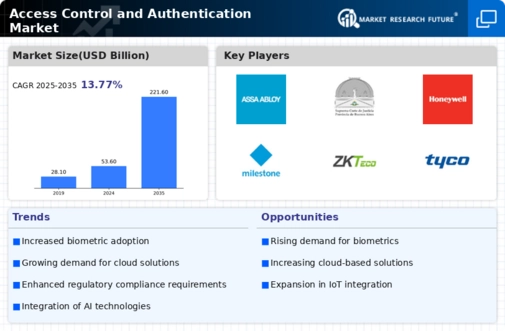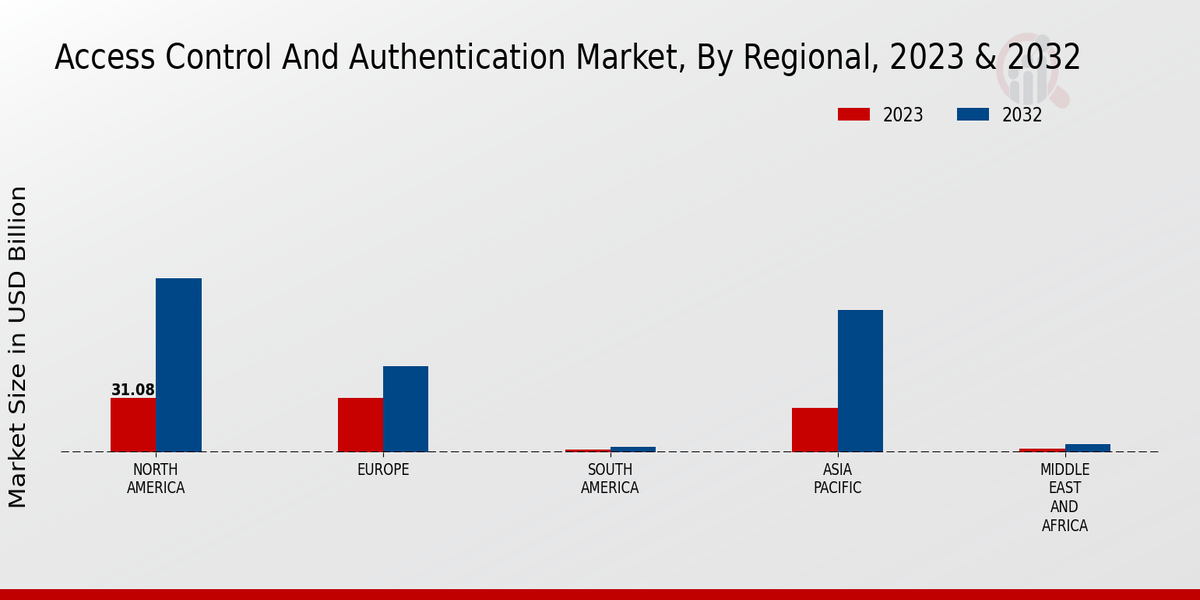Market Growth Projections
The Global Access Control and Authentication Market Industry is poised for substantial growth in the coming years. With a market valuation of 53.6 USD Billion in 2024, projections indicate a remarkable increase to 221.6 USD Billion by 2035. This growth trajectory suggests a compound annual growth rate (CAGR) of 13.77% from 2025 to 2035. Various factors, including rising cybersecurity threats, regulatory compliance requirements, and technological advancements, are driving this expansion. As organizations prioritize security and seek innovative solutions to manage access control, the market is likely to witness significant developments, reflecting the evolving landscape of access control and authentication.
Integration of IoT Devices
The proliferation of Internet of Things (IoT) devices is significantly influencing the Global Access Control and Authentication Market Industry. As more devices become interconnected, the need for secure access control mechanisms becomes paramount. Organizations are increasingly implementing authentication solutions that can manage access to a diverse range of IoT devices, ensuring data integrity and security. This trend is likely to drive market growth as businesses seek to protect their networks from potential vulnerabilities associated with IoT. The integration of IoT in access control strategies is expected to contribute to the overall market expansion, aligning with the projected growth to 221.6 USD Billion by 2035.
Rising Cybersecurity Threats
The increasing prevalence of cyber threats is a primary driver of the Global Access Control and Authentication Market Industry. Organizations are compelled to enhance their security measures to protect sensitive data from breaches and unauthorized access. In 2024, the market is valued at 53.6 USD Billion, reflecting the urgent need for robust access control solutions. As cyberattacks become more sophisticated, businesses are investing in advanced authentication technologies, such as biometrics and multi-factor authentication, to mitigate risks. This trend is likely to continue, as the demand for secure access solutions grows in tandem with the evolving threat landscape.
Regulatory Compliance Requirements
Stringent regulatory frameworks are significantly influencing the Global Access Control and Authentication Market Industry. Governments worldwide are implementing regulations that mandate organizations to adopt comprehensive security measures to protect personal and financial information. Compliance with standards such as GDPR and HIPAA necessitates robust access control systems, driving market growth. As organizations strive to meet these regulatory requirements, the demand for advanced authentication solutions is expected to rise. This trend is likely to contribute to the market's projected growth, with an anticipated increase to 221.6 USD Billion by 2035, highlighting the importance of compliance in shaping access control strategies.
Growing Demand for Cloud-Based Solutions
The shift towards cloud computing is a significant factor propelling the Global Access Control and Authentication Market Industry. Organizations are increasingly adopting cloud-based access control solutions due to their scalability, flexibility, and cost-effectiveness. These solutions allow businesses to manage access rights and authentication processes remotely, enhancing operational efficiency. As more organizations migrate to the cloud, the demand for cloud-based authentication solutions is expected to rise. This trend aligns with the overall growth trajectory of the market, which is projected to reach 221.6 USD Billion by 2035, reflecting the transformative impact of cloud technology on access control strategies.
Technological Advancements in Authentication
Technological innovations are reshaping the Global Access Control and Authentication Market Industry. The emergence of advanced technologies, such as artificial intelligence and machine learning, is enhancing the capabilities of access control systems. These technologies enable organizations to implement more sophisticated authentication methods, improving security and user experience. For instance, AI-driven analytics can identify unusual access patterns, allowing for proactive threat detection. As organizations increasingly adopt these technologies, the market is expected to experience substantial growth, with a projected CAGR of 13.77% from 2025 to 2035. This trend underscores the importance of innovation in driving market dynamics.












